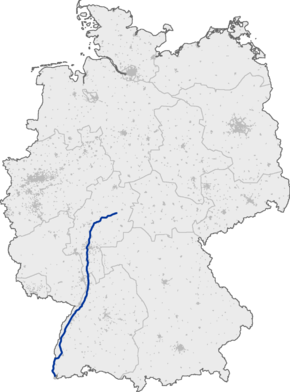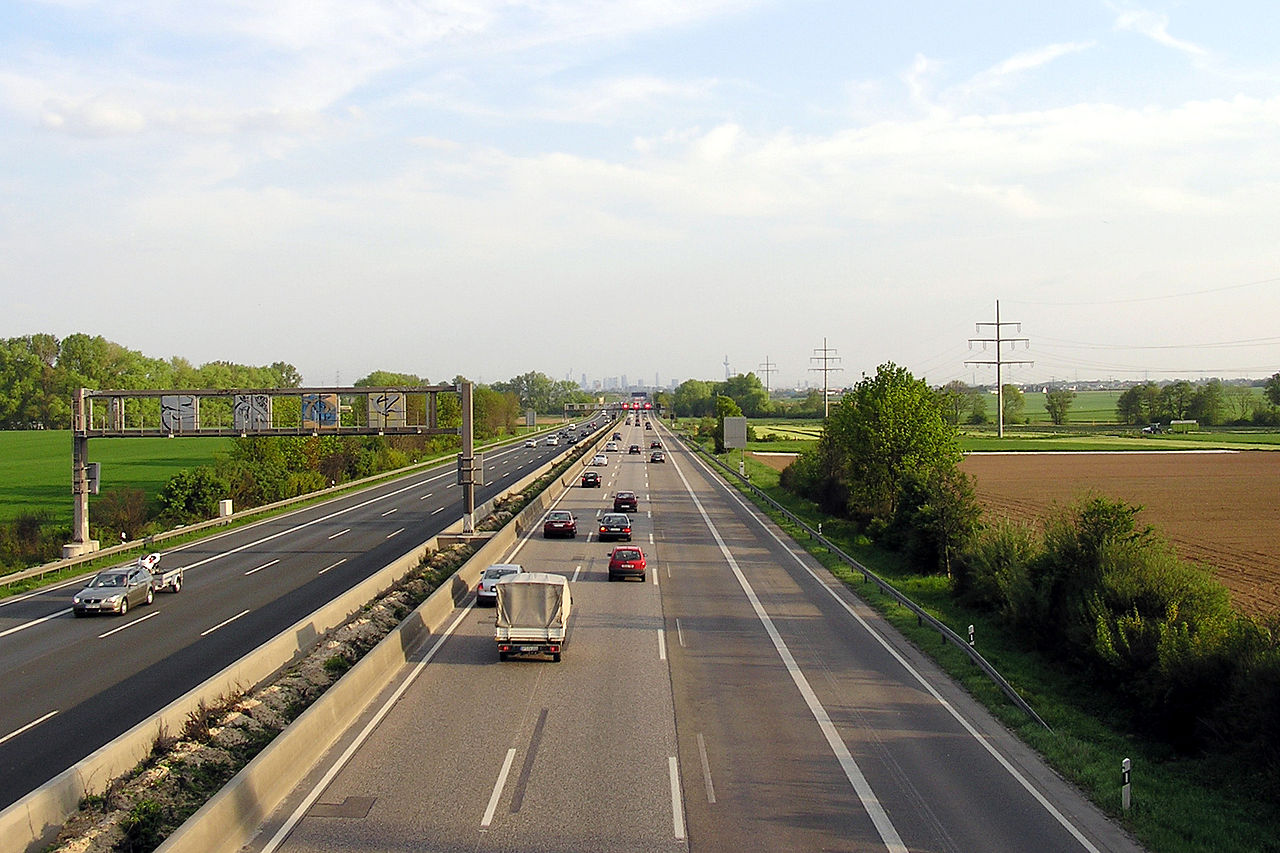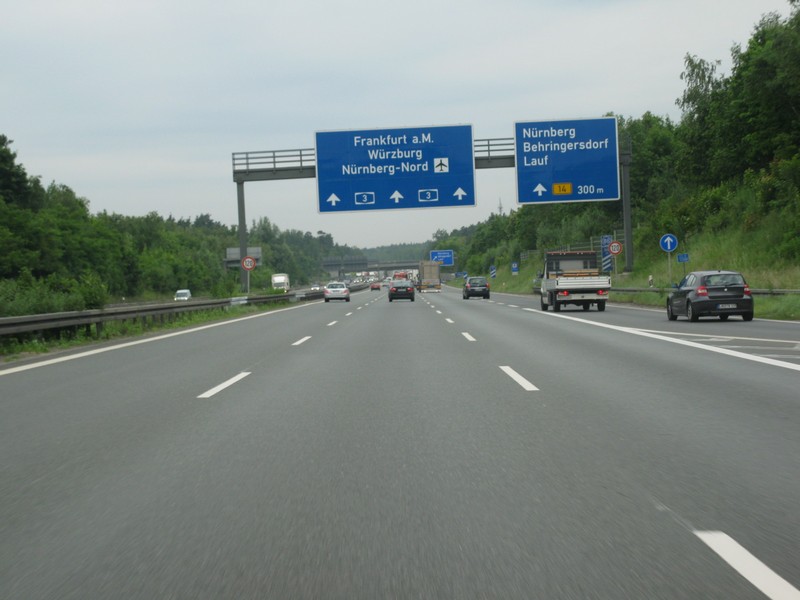Bundesautobahn 5
Template: Infobox trunk road / Maintenance / DE -A
State:
- Hesse
- Baden-Wurttemberg
- In construction
- In planning
- Traffic control system
The Federal Highway 5 (abbreviation: BAB 5) - Short Form: Highway 5 ( Abbreviation: A 5) - is a German highway from Hattenbacher triangle in Hessen via the Rhine -Main region and the Rhine - Neckar region south to the Swiss border leads at Basel and there are connections to the Swiss motorway network.
Geographically, the A 5 part one of the main through north-south motorway links Europe, Northern Europe (Oslo and Stockholm ) to Sicily and Spain. She cruises at Frankfurter Kreuz motorway A 3 from the Dutch border in the Lower Rhine to the southeast to the Austrian border near Passau. In order for this motorway junction is one of the main transport hubs in Germany. South of Freiburg im Breisgau there is a junction for connection to the French motorway network over which there is a connection to Spain or to the parallel A 35.
The total length is 440 kilometers, about 178 kilometers to about 262 kilometers in Hesse and Baden- Württemberg.
History
On September 23, 1933 occurred Chancellor Adolf Hitler broke the ground for the section of Frankfurt -Darmstadt planned North -South axis ( HaFraBa ). This section was opened on 19 May 1935. However, the A5 is not the oldest highway, but only the first autobahn in Germany. The connection motorway from Cologne to Bonn (now A555 ) was opened to traffic in 1932.
The A-5 was originally called " HaFraBa " from Hamburg via Frankfurt ( Main) to Basel planned as a single track. As part of the numbering of the German motorways but was the northern section from the Hattenbacher triangular part of A 7, which goes from the Danish border at Flensburg to the Austrian border near Kempten (Allgäu ).
The section Ettlingen Bruchhausen 1955, the section Bruchhausen -Baden -Baden in 1956 and the section of Baden- Baden, Bühl 1958 opened to traffic. 1959 was followed by the sections Bühl- Achern and garbage home / Neuchâtel - Märkt. 1960, the section Achern - Offenburg was completed, in 1961, the sections Offenburg bars and Freiburg-Süd-Müllheim/Neuenburg followed. In 1962, the gap between the bolt and Freiburg -Süd was closed in 1963 by the section between Märkt and Weil am Rhein followed. The section of Weil am Rhein to the Swiss border was opened on 14 June 1980.
The construction of the " mountain road highway " Darmstadt -Heidelberg was done in 1968 in the area between these cities a second and more direct connection to the adopted since 1975 so designated A 5, the old route is now part of the Highways 67, 6 and 656 As part of this construction project was also the section of the A 6 from Mannheim to Walldorf cross.
Former planning
The section from Hattenbacher triangle to Reiskirchener triangle was from today's launch of the numbering system in 1975, the designation A 48 The West and the eastern part of the A48 should be directly connected and A are 5 different traced out. This plan envisaged the called A 5 until 1974 in this section, A 100, by pouring over Marburg, Frankenberg (Eder ), Warburg, Lemgo, wages, Luebbecke, Sulingen and Bremen to lead up to Nordenham. In Lemgo even a motorway junction was provided with the planned Highway 35. These plans, however, were rejected in 1985. The only piece ever built the A5 north of casting is a short piece of the B 61 at the triangle wages of A 30 Here, the B 61 highway-like expanded and equipped with blue motorway signs. The short piece of highway leads into the A 30
After the final from the plans for the extension of the A 5 and the more than issue realization of the extension of the A48 motorway numbering scheme of the renumbering of the section of the A 48 to A 5 was carried out following. Impact on the numbers of connection points, this had not, as these numbers were not introduced until later.
Current state of development
The highway is four lanes on the northern section between the Hattenbacher triangle and the Gambacher cross. Only between rice churches and Homberg ( Ohm) are in the same direction Kassel three strips available. Furthermore, it was also relabeled the side stripes to a third lane in the direction of Kassel on the ascent to Rimberg.
The adjoining section between Gambacher Cross and West Cross Frankfurt is six lanes, the side strips can be opened to traffic between the junction Friedberg and Nordwestkreuz on both carriageways during peak periods, thereby are then four lanes in each direction is available.
The further course to the Darmstadt intersection is expanded achtstreifig. Only the major roadways in the Frankfurter Kreuz have only three lanes in each direction. These two sections north and south of Frankfurt Cross are among the few throughout achtstreifigen highway routes in Germany. Between the Frankfurter Kreuz junction Frankfurt- Niederrad of the side strips can be released when needed northbound also, which at times may be driven on five lanes per direction.
From the Darmstadt intersection to intersection Walldorf A 5 is only four lanes. Later on Karlsruhe and Baden -Baden to Offenburg junction are six lanes available. Here, the six-lane expansion between Baden -Baden and Offenburg was almost complete, only a 3 km long section between Appenweier and Offenburg is still under construction.
Next to the German -Swiss border, there are again only four lanes. In the last few kilometers on German territory between triangle Weil and the state boundary in a southerly direction are indeed three lanes available, but no hard shoulder; also the area until the exit Weil / Hüningen is used to issue of waiting on the custom clearance trucks.
Features, events
The chainage assumes that the A 4 from the Berliner Ring ago (triangle Potsdam Hermsdorfer Cross and Kirchheimer triangle although today no longer consistently available) and does not start at 0, but at km 372 ( Hattenbacher triangle) and listen at km 814 ( boundary to A2 in Basel) on, with a historically offset of 2 km of the Hessian- Baden-Württemberg border ( original kilometer from Darmstadt and Mannheim Four held over Weinheim).
To prevent congestion can be shared on sections from the traffic control center of the hard shoulder in the Frankfurt area as an additional lane (see Congestion Free Hessen 2015 ). A test phase with 52.5 kilometers of motorway on the A 3 and A 5 began in 2007. To this end, the affected sections are under video surveillance. On the A5 this is due to the nearly 20 -kilometer section between the Nordwestkreuz Frankfurt and the junction Friedberg the case.
The section of the Frankfurter Kreuz - Zeppelinheim / Dreieich heard with 150,700 vehicles per day on the busiest streets in Germany (9th in 2007). In the 5-year census of 2010, the section between Darmstadt -Eberstadt and Seeheim- Jugenheim with more than 100,000 vehicles was the second-most -loaded four-lane motorway section in Germany.
The A5 was the first motorway in Germany, in which a longer stretch was expanded achtstreifig.
South of Frankfurt Cross crosses under the A 5, the approach path of the Frankfurt airport directly at the beginning of two start and runways.
Also south of Frankfurt Cross stands on the site of the former Rhein- Main Air Base, the Airlift Memorial on the west side of the highway.
Between Frankfurt and Darmstadt cross all connection points are designed as trefoil crosses and link the A 5 with there four-lane highways.
High-speed tests were conducted in the 1930s south of today's Frankfurter cross on the A5. It crashed on 28 January 1938, the racing driver Bernd Rosemeyer fatal. At the parking lot after the Long / Mörfelden exit ( kilometer 508) was erected a memorial stone ( " Bernd- Rosemeyer - memorial" ).
Parts of the A 5 and A 8 were 1946-1951 used for the Karlsruhe triangle race; with prominent players such as Karl Kling and Hans Stuck.
Between Karlsruhe and Bruchsal it came on the A5 in July 2003 to a major accident, the cross-regional notoriety reached a " Autobahnraser - case " and led to the conviction of a test driver.
On 28 April 2008 the new junction Rastatt -South (50 ) has been released, which connects the A5 to the new trassierten B 3 as a bypass Sandweier. With the opening of Rastatt -south from junction Rastatt Rastatt - North has been renamed.
Between Rastatt and Baden- Baden, the top speed was reduced because of the Flüsterasphalts used. There had been accidents. The reduction but was cleared after a re- processing of the asphalt.
Adjacent to the service area Baden -Baden is the pyramidal, 1978 inaugurated Motorway Church St. Christophorus Baden -Baden.
Planning / construction
In the northernmost part of the A 5 from Hattenbacher triangle to Gambacher Cross in the Federal Transport Infrastructure Plan, a six-lane expansion is provided with the status of second priority. For the section south of the future triangle with the A 49 is planning law.
For the section from Gambacher Cross to Frankfurt in the German Federal Transport Infrastructure Plan is an extension, provided with the status of urgent requirement. From the junction Friedberg to Nordwestkreuz Frankfurt a achtstreifiger expansion is planned at 18 km in length. Planning is Environmental Impact Assessment in status. The effects of the project on humans, soil, water, air, climate and landscape are identified and evaluated. Possible variants of the structural implementation of the achtstreifigen expansion in the next step based on the Environmental Impact Assessment - examines the technical and professional aspects, environmental - Expansion to the right or left. The current planning foresees that 24 Structures / overpasses newly built, four widened and three would have to be demolished without replacement. The expansion aims to improve the traffic conditions and increase road safety. Furthermore, as before also, the hard shoulder may be temporarily released as lanes.
Since the already eight-lane section between the West and the Frankfurter Kreuz Kreuz Frankfurt reaches its capacity limit, a zwölfstreifiger expansion is planned for this route. Due to the short sequence of multiple connection points remote and local transport their own roads to get there. The problem with this plan is that the highway leading in this area through the heavily built-up area of the Frankfurt neighborhoods Griesheim, Gallus and Goldstein. The planning work has not yet begun in late 2009. In contrast, the previously existing only from the south exit Frankfurt -Niederrad on July 8, 2013, from the north passable. A special feature of the new connection point is, that the exit is about 500 meters behind the driveway because the Main permits no other option.
Outside of the demand plan a complete reorganization of the node range Darmstadt is provided in the long term. In addition to extensions and conversions in the Darmstadt cross this concerns mainly the construction of new Abbiegerampen to and from the A672 to Darmstadt as well as a separate truck lane for traffic coming from Frankfurt to the south, beginning between AS Weiterstadt and triangle Darmstadt, past the intertwining areas to to the main lanes of the A 5 towards Heidelberg and A67 towards Mannheim Darmstadt Cross.
Between the Darmstadt intersection and the cross Walldorf a six-lane expansion is planned. Only the southernmost part from the Cross Heidelberg was classified as urgent. The rest is planned as a second priority.
The further course of the Cross Walldorf to the junction Karlsruhe-Süd will be equipped with eight lanes. Planning is also classified as second priority in the Federal Transport Infrastructure Plan with status.
For the section between Baden -Baden and Offenburg began in May 2009, the planning for the execution of building a six-lane expansion by the private consortium Via Solutions southwest. The consortium is now 30 years template: responsible future / In 5 years for the maintenance and operation, winter and dry cleaning service, garden maintenance, maintenance, route control and emergency services as well as for the associated coordination and traffic management. A Offenburg junction -South is also newly created. In the summer of 2009, preparatory work began. This forest has been cleared and demolished a bridge. In the following months, more bridges were demolished before the beginning of 2010 did the actual construction. 18 September 2011 by 14 clock of the first, fully modernized expansion section went into operation. In this case, a strip in each direction was closed at the request of the police, and thus it remained at the four-lane traffic flow, since a constant alternation between two and three tracks increases the risk of accidents. The plan was that the entire section of Baden -Baden to Offenburg is expanded through six lanes by the end of 2013. Until December 19, 2013 already 38.5 of the 41.5 km long rail line transport were passed three lanes between Baden -Baden and Appenweier. What remains is a 3 km long section between junctions Appenweier and Offenburg. In November 2013 West Via Solutions announced that the final section to be completed for financial reasons only in September next year.
The six-lane expansion of A 5 is planned to continue to the border crossing Weil. Only the section from junction to junction Teningen Freiburg-Mitte is this planned priority, the rest is in more demand.
The construction of an additional junction Rastatt Center was in the spring of 2009 in the pre-planning stage. In 2012, however, the authorities in Karlsruhe introduced the now- favored plan to expand the junction Rastatt north into a full clover. This project is found in the list of 158 highway construction projects in Baden-Württemberg state government, which was filed in early October 2013 in the Federal Government for the continuation of the Federal Transport Infrastructure Plan. On this list there is also the mentioned six lanes planned expansion of Offenburg to Bad Krozingen, which was planned in the list discussed starting in March 2013, to the Swiss border, but was now reduced to this section because of sufficient capacity. Also listed is the planned expansion to six lanes between Hemsbach and the motorway intersection Walldorf and the expansion from six to eight lanes between Walldorf and Karlsruhe. The latter was, however, reduced by the portion between the motorway junction Karlsruhe and Karlsruhe-Süd junction.



,_Richtungsanzeiger.JPG/220px-Dreieck_Karlsruhe_(2012),_Richtungsanzeiger.JPG)




